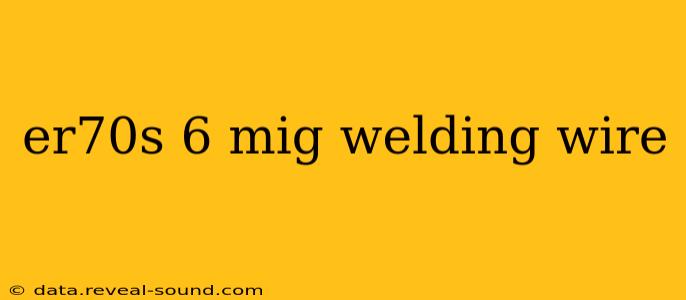ER70S-6 MIG welding wire is a popular choice for a wide range of applications due to its versatility and excellent weld quality. This comprehensive guide will delve into its properties, uses, and considerations for optimal performance. We'll also address some frequently asked questions to provide a complete understanding of this essential welding consumable.
What is ER70S-6 Welding Wire?
ER70S-6 is a solid wire, meaning it doesn't contain a flux core. The "ER" designation signifies it's an electrode for arc welding. "70" indicates its tensile strength (70,000 psi), representing its ability to withstand stress. The "S" denotes it's a solid wire, and the "6" specifies its specific chemical composition and mechanical properties, optimized for a balance of strength, weldability, and ductility. This makes it highly suitable for a variety of mild steels.
What are the Properties of ER70S-6 Welding Wire?
ER70S-6 boasts several key properties that contribute to its widespread use:
- High Tensile Strength: Its 70,000 psi tensile strength ensures strong, durable welds.
- Excellent Weldability: It's known for its ease of use and produces smooth, consistent welds.
- Good Ductility: This allows for flexibility in the weld, reducing the risk of cracking.
- Low Spatter: This minimizes cleanup time and improves weld aesthetics.
- Versatility: Suitable for various applications, including automotive repair, fabrication, and general construction.
What are the Common Applications of ER70S-6 Welding Wire?
The versatility of ER70S-6 makes it a staple in numerous industries:
- Automotive Repair: Widely used for repairing body panels, bumpers, and chassis components.
- Fabrication: Ideal for constructing metal structures, machinery parts, and other fabricated items.
- General Construction: Employed in various construction projects, including welding structural steel and pipelines.
- Manufacturing: Used in the production of a wide range of metal products.
What is the Difference Between ER70S-2 and ER70S-6?
While both are solid wire electrodes with similar tensile strength, ER70S-6 typically offers slightly improved weldability and lower spatter compared to ER70S-2. The subtle differences in chemical composition account for these performance variations. The choice often depends on specific application requirements and welder preference.
What Gas Should I Use with ER70S-6 Welding Wire?
ER70S-6 is typically used with a shielding gas mixture of 75% Argon and 25% CO2 (often referred to as C25), although 100% CO2 can also be employed. The gas mixture choice influences the weld's properties, including penetration and appearance. The use of 100% CO2 usually results in higher penetration but can increase spatter.
What are the Best Practices for Using ER70S-6 Welding Wire?
For optimal results when using ER70S-6, consider these best practices:
- Proper Gas Coverage: Ensure adequate shielding gas coverage to prevent oxidation and porosity in the weld.
- Correct Wire Feed Speed: Adjust the wire feed speed to maintain a consistent arc and good weld bead formation.
- Appropriate Voltage and Amperage: Use the appropriate voltage and amperage settings for the material thickness and wire diameter.
- Cleanliness: Ensure the welding surfaces are clean and free from contaminants.
Conclusion
ER70S-6 MIG welding wire is a reliable and versatile option for various welding projects. Understanding its properties and employing best practices will lead to high-quality, durable welds. By carefully considering the specific application requirements and choosing the right gas mixture, welders can achieve excellent results with this widely used welding consumable. Remember to always prioritize safety and follow proper welding procedures.
